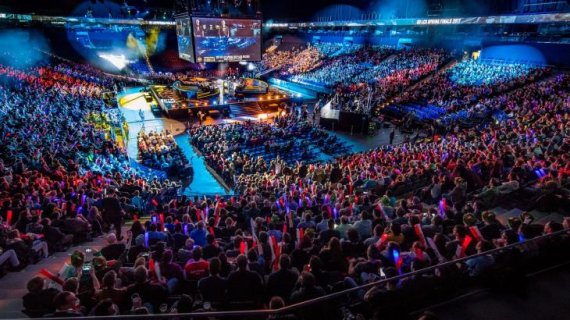
Christoph Rapp, International Sales & Retail Manager at Messe München, deals with the issues of the sporting goods industry on a daily basis.hemes of the sporting goods industry. He has his finger on the pulse of the times, and prepares the topics relevant to the industry for ISPO Academy. The first event in the ISPO Academy Connect series was about "The Future of the Sporting Goods Industry - Opportunities - Change and Trends," while the second event was about start-ups and the question of what founders really need. And so now, at the third event at Weststudio in Munich's West End, it's about Esports. "At first glance, our topic may not be obvious to some, but it is very obvious to others," said Rapp. Behind it is the still much debated question: is Esports actually sport or not?
"It's competitive entertainment," says André Fläckel, the director of Esports at Lagadère - before committing: "Esports is on its way to becoming one of the most important sports worldwide." And that means that sooner rather than later, the question for every player in the sports business is whether and how to get involved. Fläckel cites the most important reason: "The target group is young," 16 to 25 years old, "better educated than average and increasingly difficult to reach through classic channels."
The wastage among this target group is enormous - in Esports, on the other hand, you have the best chance of reaching a target group that is currently facing "many first-time experiences," as Cédric Schulte-Langforth, Manager New Business at Lagadère Plus, explains, i.e., that is buying a car for the first time, taking out an insurance policy, possibly becoming committed to a brand in the long term: "This target group is uniquely attractive," says Schulte-Langforth.
Lagadère presents facts and figures that illustrate the growth market of Esports:
- 1.5 billion people amuse themselves with video games. "That still has nothing to do with professional sports," says André Fläckel, but it shows the potential.
- 365 million people consume and watch Esports events. And the trend is rising. "It's a very young market that's constantly moving," says André Fläckel, analyzing, "No sport is developing faster than Esports."
- For the live event of the Blast Pro series, 12,000 people came to the Royal Arena Copenhagen at the end of November, the event was broadcast in 89 countries, several millions watched worldwide.
- At the League of Legends finals, 43 million people worldwide already watched in 2016, and in 2017 it was as many as 75 million. The total prize money was $24 million - by comparison, the European soccer association Uefa pays out $8.1 million in the Euro League.
- 700 million dollars was generated by Esports last year.
- Esports will become an officially recognized competition at the 2020 Asia Games, so gold medals will be at stake for the first time by an international sports federation.
- Team SK Gaming, No. 1 in the game Counter-Strike, has a reach of 5.3 million on social networks - something only a few clubs in the German soccer league manage.
- 76 percent of Esports fans are between the ages of 10 and 35, another 22 percent are between 36 and 50, and only 3 percent are 51 and older. 66 percent of those interested in Esports are men, 34 women.
- 48 percent have an above-average household income
Lagadère Sports advises companies on strategic issues and is one of the most important marketers in Esports. In order to check whether a sponsorship commitment makes sense for a company, it is first important to know the market players to know.
- Publishers are the companies that produce Esports games. EA Sports, for example, or Valve, a 7 billion company.
- Media: Esports runs primarily on streaming platforms. Twitch.tv is the number 1 Esports platform, far ahead of YouTube Gaming. In the linear sector, TV channels such as ESPN and, in the German market, Sport 1 broadcast. Facebook, Amazon and even the Walt Disney Company are also getting in on the act.
- Sports teams are now also entering the Esports market from established clubs: FC Schalke 04, Paris St. Germain, Manchester City, FC Valencia, and even the Philadelphia 76ers.
- Sponsorship: Initially, the brands came mainly from the endemic sector, from the computer industry and its suppliers, Logitec and Acer for example. Recently, however, more and more global consumer goods brands are getting on board. Examples: BMW, Mercedes, Red Bull, Vodafone, Visa, Gerolsteiner, Jack & Jones.
"The movement in sponsorship is perceived more significantly than in most other sports.
The movement in sponsorship is perceived more significantly than in most other sports," says Cédric Schulte-Langforth, which is a great opportunity for the brands entering the game. However, one must always be aware that the target group reacts very sensitively: "When a large company enters Esports, it triggers enthusiasm among the fans - but they are also critical and observe exactly how the sponsor behaves.
Using three best-case examples, Schulte-Langforth explains how brands get involved in Esports and what guiding principles can be derived for corporate entry.
- Create added value for fans. Take Gerolsteiner, for example. The beverage manufacturer sponsors the German team Unicorns of Love. And in videos on the social media platforms, it shows on the one hand that Esports pros don't conform to the outdated cliché (i.e., they don't just drink Coke, eat pizza, hide in the basement), but are fit endurance athletes. Gerolsteiner brings videos with insights from the team, accompanies the team to the gym, in everyday training and to competitions. In this way, the sleeve sponsor presents itself as a lifestyle-conscious and young brand - not with heavy-handed advertising, but with real information and entertainment for the fans.
- Esports must remain authentic. Take BMW, for example. The automobile manufacturer sponsored the European League of Legends Championship Series (EU LCS) summer final in Paris - and When the Unicorns of Love failed to qualify, BMW nevertheless brought their top star and team manager Romain Bigeardan icon of esports, to the #LaneToParis, the hashtag on the social networks - with a graffiti model of the M3. BMW even dispensed with its established CI design and tied its logo into the marketing space in a way that was tailored to Esports.
- Take what you do best - and share it with the scene. Take Jack & Jones, for example. The apparel manufacturer outfitted CS:GO team Astralis with its own collection: Hoodies, shorts, pants, very stylish and made for the Esports target group. The Astralis pros are available as campaign models, and the collection is now also available online and in flag stores.
What are the challenges for the Esports market? André Fläckel names four points:
- Even more traditional brands will get involved - in recruiting and employment, with content creation, activating influencers and ambassadors, and with knowledge and image transfer.
- To do this, they need a better understanding of the target group.
- Brands have to adapt to the market - for example, in addressing the target group.
- Esports needs even more professional structures in its associations and organizations - and a clear ability to plan events. The players in Esports must ensure greater transparency in KPIs and standards that large companies now follow.
LoL Esports The official League of Legends esports Instagram
- Awards
- Mountain sports
- Bike
- Fitness
- Health
- ISPO Munich
- Running
- Brands
- Sustainability
- Olympia
- OutDoor
- Promotion
- Sports Business
- Textrends
- Triathlon
- Water sports
- Winter sports
- eSports
- SportsTech
- OutDoor by ISPO
- Heroes
- Transformation
- Sport Fashion
- Urban Culture
- Challenges of a CEO
- Trade fairs
- Sports
- Find the Balance
- Product reviews
- Newsletter Exclusive Area
- Magazine




